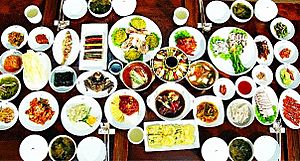Korean table d'hôte facts for kids
| Korean table d'hôte | |
 |
|
Quick facts for kids Korean name |
|
|---|---|
| Hangul |
한정식
|
| Hanja |
韓定食
|
| Revised Romanization | han-jeongsik |
| McCune–Reischauer | han-chŏngsik |
| IPA | [han.dʑʌŋ.ɕik̚] |
Imagine a meal where your table is covered with many small, colorful dishes! That's what Korean table d'hôte, known as han-jeongsik (한정식; 韓定食) in Korean, is all about. It's a special Korean full-course meal. It features a wide variety of small side dishes called banchan, each with its own unique taste and color.
Contents
What is Han-jeongsik?
Han-jeongsik is more than just food; it's an experience. It's a traditional way of serving a Korean meal where many dishes are brought out at once. This creates a beautiful spread of food. Unlike some Western meals where courses come one after another, in han-jeongsik, almost everything arrives together.
A Feast for Your Eyes and Taste Buds
The main idea behind han-jeongsik is to offer a balanced meal. It includes a mix of flavors, textures, and colors. You'll find everything from savory meats to fresh vegetables, often prepared in different ways.
Key Parts of a Han-jeongsik Meal
Every han-jeongsik meal usually includes a few main items:
- Bap (rice): This is the most important part of any Korean meal. It's usually plain white rice.
- Guk (soup): A warm soup is always served. It can be clear or thick, depending on the type.
- Banchan (side dishes): These are the stars of han-jeongsik. There can be dozens of them! They include kimchi, seasoned vegetables, stir-fried dishes, and more. Each banchan is meant to be eaten with the rice and soup.
Special Dishes You Might Find
Besides the basics, han-jeongsik often includes special dishes like:
- Grilled fish or meat: Often served as a main protein.
- Jeon: Korean pancakes made with various ingredients like vegetables or seafood.
- Japchae: Sweet potato noodles stir-fried with vegetables and meat.
- Stew (jjigae): A hearty, flavorful stew, often spicy.
The History of Han-jeongsik
Han-jeongsik has deep roots in Korean history. It developed from the meals served in royal palaces and noble homes. These meals were carefully prepared to be both delicious and healthy. Over time, this style of dining became popular among ordinary people too. Today, it's a way to experience traditional Korean hospitality and cuisine.
Regional Differences in Han-jeongsik
Just like food varies from state to state in your country, han-jeongsik can be different depending on the region in Korea. For example, a han-jeongsik meal from Jeolla Province might be famous for its rich seafood dishes. A meal from Gyeonggi Province might feature more mountain vegetables. This shows the diverse ingredients and cooking styles across Korea.
Similar Meals Around the World
The idea of a meal with many small dishes isn't unique to Korea. Other cultures have similar traditions:
- Meze: This is a selection of small dishes served in the Middle East and Balkan countries.
- Smörgåsbord: A type of buffet meal from Scandinavia, where many dishes are laid out for people to choose from.
- Thali: A round platter used in South and Southeast Asia. It comes with a selection of various dishes served in small bowls.
Han-jeongsik is a wonderful way to explore the rich flavors and traditions of Korean food. It's a meal that brings people together to share and enjoy a wide variety of delicious dishes.
See also
 In Spanish: Hanjeongsik para niños
In Spanish: Hanjeongsik para niños

